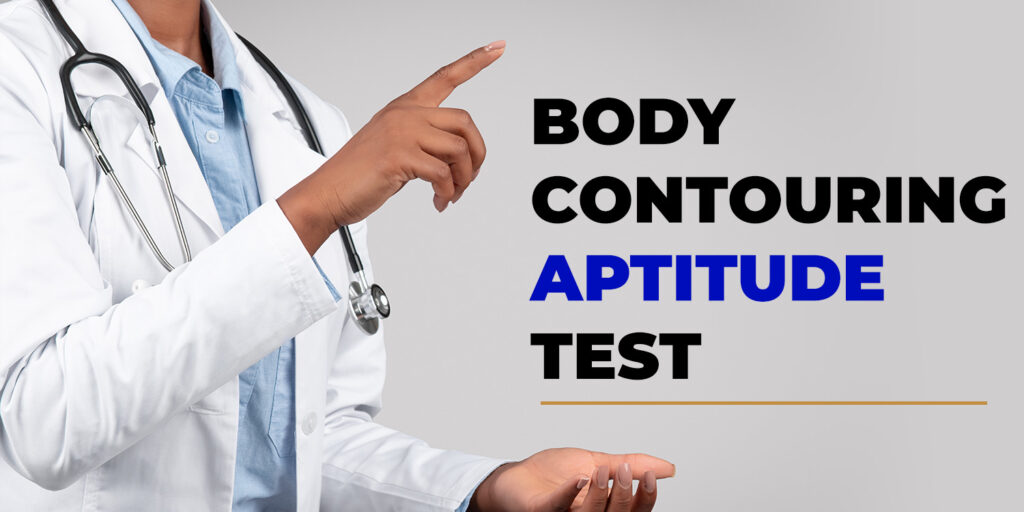Welcome to the Body Contouring Aptitude Test.
This exam is designed to explore your knowledge of body altering aesthetics and your knowledge of the depth of the treatment applications void of client care negligence
There are two parts to this examination: a short series of multiple choice questions and a handful of open ended questions.
Your results will be sent to you via email in two parts: one with your instant results and the other within 3 business days of your submission. This exam takes about 15-20 minutes to complete. Your answers will include explanations based on the most up to date research and science.
0 of 24 Questions completed
Questions:
You have already completed the quiz before. Hence you can not start it again.
You must sign in or sign up to start the quiz.
You must first complete the following:
Quiz complete. Results are being recorded.
0 of 24 Questions answered correctly
Time has elapsed
You have reached 0 of 0 point(s), (0 )
Earned Point(s): 0 of 0 , (0 ) 0 Essay(s) Pending (Possible Point(s): 0 )
Show Question
1
Show Question
2
Show Question
3
Show Question
4
Show Question
5
Show Question
6
Show Question
7
Show Question
8
Show Question
9
Show Question
10
Show Question
11
Show Question
12
Show Question
13
Show Question
14
Show Question
15
Show Question
16
Show Question
17
Show Question
18
Show Question
19
Show Question
20
Show Question
21
Show Question
22
Show Question
23
Show Question
24
Review
Answered
Correct
Incorrect
Question 1 of 24
1 point(s)
Client with a 33 BMI comes in for a body contouring treatment. This is their first session with you. You take their measurements and her waist is a 35 with a substantial amount of superficial subcutaneous tissue and an equal amount of visceral cellular waste. She has a moderate amount of skin laxity, mild cellulite, and faint stretch marks. She is fair skin in complexion, is a post bariatric patient from 10 years ago, and has body goals to tighten and tone her loose skin.
Question 2 of 24
1 point(s)
2. While applying the vacuum attachment during a nonsurgical body contouring treatment, you opt to use the technology to break down adipose tissue first, and then to move the broken down tissue towards collecting lymph nodes. What are the device settings to achieve these results?
Question 3 of 24
1 point(s)
3. You have a nonsurgical body contouring client with thick dermal tissue. The client is 5 ‘1 ” with a BMI of 36 and most of their tissue is located in deep adipose layers within their midsection. The client’s body goals are to slim their midsection with more even skin integrity. While building your protocol, you decide to focus on applying cavitation technology and want to use your more powerful device for the application. You have a cavitation attachment that is a part of an all-in-one device with other technology inclusive of g5, laser lipo, and radiofrequency. You also have a stand-alone panda box cavitation machine. Which cavitation head do you select to achieve the desired goal?
Question 4 of 24
1 point(s)
4. What is the maximum amount of time an ultrasound device can be used per area during a nonsurgical body contouring treatment?
Question 5 of 24
1 point(s)
5. You want to amplify a client’s body contouring session in breaking down fat in helping them achieve a smaller waistline. During the client’s protocol, you opt to include cavitation, radio frequency, and ultrasound treatments. Which emollient additive can you mix in with the ultrasound gel to enhance their fat reduction and improve results?
Question 6 of 24
1 point(s)
6. A client arrives for a nonsurgical body contouring treatment. The practitioner greets them and escorts them to the treatment room. After discussing the procedure, the practitioner asks the client to lie down on the treatment table. They step out to grab a new pair of gloves. Upon returning they ask permission to roll down the clients jeans a little more to more expose the treatment area. They finish their soap notes and then place their gloves on. The practitioner begins the treatment. Based on the available information, what is wrong in this scenario?
Question 7 of 24
1 point(s)
7. Which device should a therapist never use Sani-cloths on while disinfecting?
Question 8 of 24
1 point(s)
8. Which of the following statements correctly distinguishes between subcutaneous fat and visceral fat?
Question 9 of 24
1 point(s)
9. Marketing companies have gotten really comfortable with incorrectly advertising how their technology breaks down adipose tissue. Which of the following correctly expresses how a sauna blanket treatment accurately expresses fat breakdown within the body?
Question 10 of 24
1 point(s)
10. Explain how wood therapy helps to tighten loose skin?
Question 11 of 24
1 point(s)
11. Before starting a body contouring treatment with a new client, which of the following should a therapist do? Select the most correct answer.
Question 12 of 24
1 point(s)
12. A client is interested in a more aggressive body contouring experience. Which is the following you should suggest to help them reach their body contouring goals faster? Select the most correct answer.
Question 13 of 24
1 point(s)
13. What is the difference between body contouring and Brazilian massage techniques?
Question 14 of 24
1 point(s)
14. Fill in the blanks: To elicit [semi] permanent results, body contouring requires activating the
Question 15 of 24
1 point(s)
15. After adipose tissue is broken down and enters the lymphatic system, it enters the lymphatic vessels, eventually converging into the bloodstream primarily at the _____________ _____.
Question 16 of 24
1 point(s)
16. The lymphatic system works heavily in conjunction with the immune system. Where is 70% of the immune system located within the body?
Question 17 of 24
1 point(s)
17. Describe the anatomical changes associated with an everted rib cage. What impact will this have on the client’s body contouring treatments that the client should be made aware of?
Question 18 of 24
1 point(s)
18. Which of the following nonsurgical facial contouring techniques primarily aims to tone the skin?
Question 19 of 24
1 point(s)
19. Which of the following is a contraindication for wood therapy?
Question 20 of 24
1 point(s)
20. A client buys a body contouring package that has her coming in for sessions three times a week. To ensure the client doesn’t reach a body plateau, what does the therapist need to do?
Question 21 of 24
3 point(s)
21. A 37 y/o nonsurgical body contouring client with two children– the youngest being 6 y/o and the oldest being 11 y/o– began a package at your spa. She has a slight diastasis recti and faint mild stretch marks. Her goal is to encourage skin retraction, toning her loose skin, and shrinking her waistline to resemble her pre-baby body. Considering the client’s medical history, what challenges or factors might influence treatment outcomes?
This response will be reviewed and graded after submission.
Grading can be reviewed and adjusted.
Grading can be reviewed and adjusted.
Question 22 of 24
3 point(s)
22. Explain what happens internally if you take a client over the safety BMI limit of a 42, specifically stating the effects it has on the following organs: heart, liver, & kidneys.
This response will be reviewed and graded after submission.
Grading can be reviewed and adjusted.
Grading can be reviewed and adjusted.
Question 23 of 24
3 point(s)
23. True or False– The following treatment was performed correctly: A client complains about the fat along their intercostals and directly under their breast tissue during their initial intake. To treat this area, their therapist uses cavitation across the clients upper torso to decrease their bra roll fat, and the fat along their flanks. This helps to reduce the subcutaneous tissue around the sternum and ribs, better sculpting the thoracic cavity and torso definition. If true, explain why this is correct. If false, explain why this is incorrect.
This response will be reviewed and graded after submission.
Grading can be reviewed and adjusted.
Grading can be reviewed and adjusted.
Question 24 of 24
3 point(s)
24. A 45-year-old client is scheduled for body contouring treatments. They underwent liposuction four months prior and are seeking to refine their body shape. Compare and contrast the expected tissue characteristics and treatment considerations for this client compared to a client with no prior surgical history. What are key factors for postOp body contouring (POBC) vs nonsurgical body contouring (NSBC) clients?
This response will be reviewed and graded after submission.
Grading can be reviewed and adjusted.
Grading can be reviewed and adjusted.

